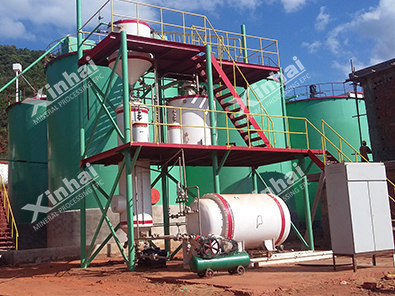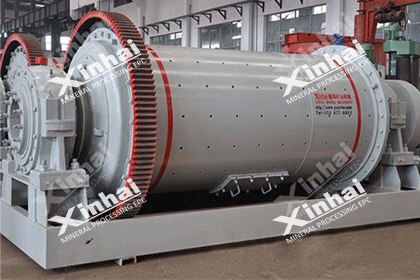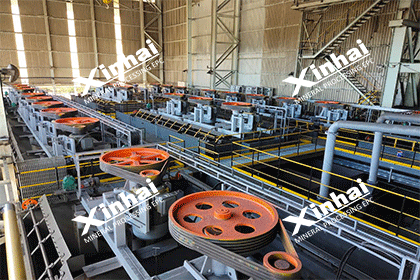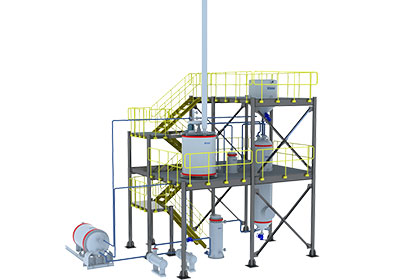How to Extract Gold From Ore?
 Shirley
Shirley
 Feb 11, 2022
Feb 11, 2022
 3848
3848
If you want to know more details about equipment, solutions, etc, please click the button below for free consultation, or leave your requirements!
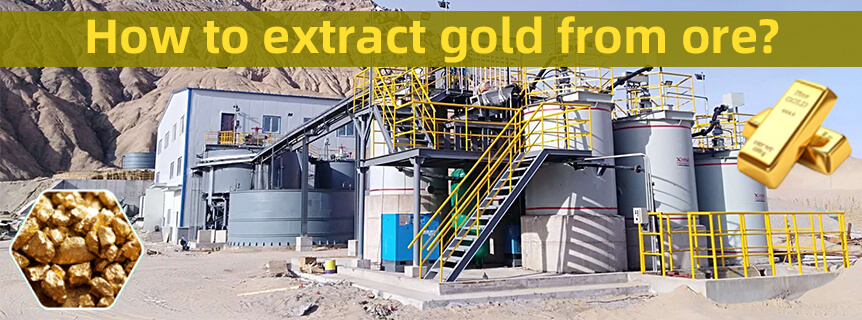
Common gold ore extraction processes mainly include cyanidation, flotation and gravity separation. Based on different mine properties, each gold processing plant should choose a scientific and reasonable gold beneficiation method. The following will teach you how to extract gold from ore.
01 Gold Cyanidation Method
BackThe cyanidation method is one of the main methods of gold ore beneficiation, which can be divided into two categories: agitation cyanidation and percolation cyanidation. Agitation cyanidation is mainly used for the treatment of flotation gold concentrate, or in the all-slime cyanidation, while percolation cyanidation is mainly used for the treatment of low-grade gold-bearing oxide ores.
Because of the disadvantages of sodium cyanide and the current environmental protection requirements, CNLITE Mining Reagent Co., Ltd has successfully developed an environmentally friendly gold ore dressing reagent to replace sodium cyanide for gold cyanidation. The method of application is the same as that of sodium cyanide, but it has many benefits, including higher recovery speed, higher leaching rate and lower cost.
(1) Agitation Cyanidation Method for Gold Extraction
Agitation cyanidation gold extraction process mainly includes two types:
One is the cyanidation-zinc replacement process (CCD method and CCF method) that recovers gold by replacing precipitation with zinc powder (wire) through continuous countercurrent washing.
The other is the non-filtering cyanide carbon slurry process (CIP method and CIL method) that uses activated carbon to directly absorb and recover gold from the cyanide pulp without filtering and washing.
① Cyanidation-Zinc Replacement Process (CCD Method and CCF Method)
The cyanidation-zinc replacement process (CCD method and CCF method) is used to treat gold-bearing solution after leaching. The principle is to use zinc powder (wire) as a reducing agent to replace gold and silver from the leaching solution.
The process mainly include countercurrent washing solid-liquid separation, leaching solution purification, deoxidation and zinc powder (wire) replacement.
② Carbon in Pulp/Leach Gold Extraction Process (CIP method and CIL method)
The carbon in pulp /leach gold extraction process (CIP method and CIL method) is to put activated carbon into the cyanide slurry, adsorb the dissolved gold on the activated carbon, and then extract the gold from the activated carbon.
This process mainly including leaching raw material preparation, agitation leaching and countercurrent carbon adsorption, gold-loaded carbon desorption, electrowinning, smelting ingot, carbon regeneration and other operations.
③ Cyanidation-ion Exchange Resin Adsorption Method for Gold Extraction
The ion exchange resin adsorption method is basically similar to the leaching and adsorption process of the CIP/CIL method. The difference is that the carbon is replaced with ion exchange resin. This process includes operations such as gold-loaded resin desorption electrolysis, smelting ingot, and resin regeneration.
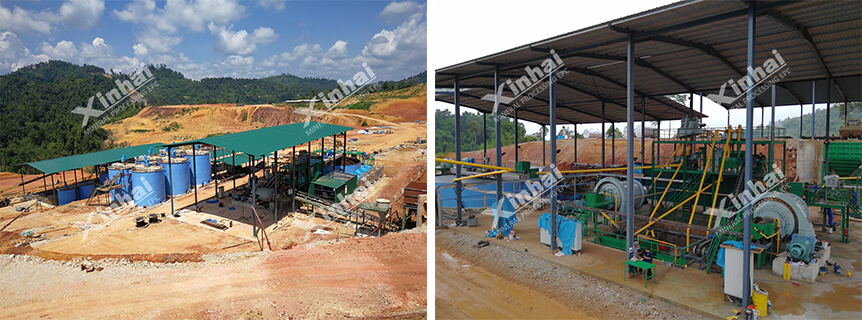
(Gold cyanidation plant in Malaysia)
(2) Percolation Cyanidation Method for Gold Extraction
The percolation cyanidation method is also one of the cyanide leaching processes. Its principle is that the cyanide solution penetrates through the ore layer to leach the gold from the gold-bearing ore. It is suitable for alluvial and loose porous materials.
There are two kinds of percolation cyanidation methods: pool leaching and heap leaching.
After the cyanide leaching solution percolate and leach the gold out, we can then treat the gold-bearing solution with ion exchange resin, activated carbon adsorption or zinc powder (wire) replacement to get the gold mud.
① Pool Leaching Process
The percolation leaching is generally carried out in the percolation leaching tank, which usually is a wooden tank, an iron tank or a cement tank. The bottom of the pool is horizontal or slightly inclined, round, rectangular or square.
The leaching tank is equipped with a false bottom made of a perforated acid-resistant plate. The false bottom is covered with filter cloth, and the filter cloth is covered with a grid with wooden or corrosion-resistant metal strips.
When leaching, we load the ore in the tank, and add the leaching reagent to the top of the tank. The leaching solution flows out from the lower part of the false bottom. The false bottom is used to filter and support the ore.
The penetration rate mainly depends on factors such as the height of the material, the porosity of the material, the degree of mud content, the viscosity of the leaching reagent, and the characteristics of the material itself.
② Heap Leaching Process
The process of heap leaching is mainly to transfer the mined ore to a pre-prepared storage yard for pile, or directly pile on the waste rock or low-grade ore, the spray or infiltrate the cyanide leaching reagent, so that the reagent can pass through the ore and make the gold in it be leached.
After the leaching solution repeatedly circulated and sprays the ore pile, we can collect the leaching solution, and then using ion exchange resin, activated carbon adsorption or zinc replacement to get gold mud, the solution without gold can be returned to the heap leaching operation for recycling.
The heap leaching site generally is a gentle slope mountain (natural slope 5-15˚) close to the mine site and convenient for transportation. After removing the weeds and floating soil first, we should then compact the soil to build a foundation with a slope of about 5˚, with the two sides high and the middle slightly lower, which is convenient for the leaching solution to flow into the storage tank in a concentrated manner, and then cover the storage yard with a geomembrane to prevent leakage. Then we build a 0.4m soil ridge around the storage yard and use it as a waterproof ditch to prevent rainwater from flowing into the yard. Before piling up the ore, we can pile up the 0.3m thick lean ore first.
The heap leaching method has low production cost and can be put into production quickly, and the heap leaching scale can be large or small. After the ore is crushed to a certain size or granulated, it can be piled to get leached.
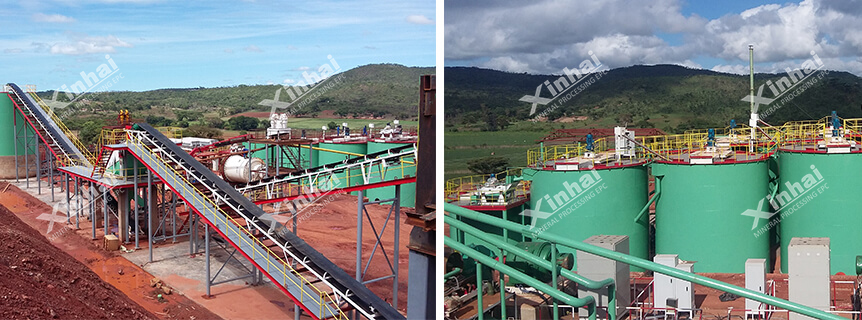
(Gold cyanidation plant in Zimbabwe)
02 Gold Flotation Method
BackFlotation is a beneficiation method widely used in a plant for processing gold. It is often used to process gold-bearing sulfide minerals with high floatability. Float gold into copper and lead concentrates, and then extract gold from these concentrates. Therefore it's a relatively economical and reasonable process for gold ore containing ferrous metals in the original ore, which can realize the comprehensive utilization of multiple metals and enrich the gold in sulfide minerals as much as possible.
In order to increase the rate of return on investment, the beneficiation process combining flotation and other processes can sometimes achieve more impressive results for ores of different properties.
(1) Flotation-Cyanide leaching of concentrate
This gold beneficiation method is often used to process gold ore containing gold-bearing quartz veins and gold-bearing golden iron ore veins. Generally, we use xanthate for a collector and terpineol for a foaming agent to float the weakly alkaline slurry in the flotation machine and obtain gold concentrate. Then the flotation concentrate is leached again by cyanide, which makes the gold dissolve by cyanide and the complex enter the solution, and then replaced with zinc powder to obtain gold mud, and finally the gold mud is smelted to obtain pure gold.
(2) Flotation-Thiourea leaching of concentrate
For vein gold ore with high arsenic and sulfur or high carbon and argillaceous, we can use the flotation method to obtain gold-containing sulfide concentrate, and then leach the flotation concentrate with thiourea to recover gold.
The thiourea method for gold extraction is a new low-toxic gold extraction process which is improving day by day. The thiourea acid solution dissolves gold and silver at a high speed, low toxicity, and easy to regenerate. Antimony, arsenic, copper, sulfur and other mineral components are not sensitive to gold extraction by thiourea, but will affect it by cyanidation. Therefore, thiourea leaching can extract gold and silver from gold-bearing minerals that are difficult to treat by cyanidation. At the same time, the time of thiourea leaching is generally much shorter than cyanide leaching.
(3) Flotation-Concentrate roasting-High acid washing-Cyanide leaching
For flotation concentrates containing high arsenic and sulfur, after flotating the cyanide tailings, sulfur, iron, arsenic and other impurities are enriched in the concentrate to become difficult to select high-sulfur and high-arsenic concentrates, and cannot be directly cyanided. In this situation, we can put the flotation gold concentrate in the process of oxidative roasting first to remove arsenic and sulfur, so that the structure of the calcine after roasting is loose, which is more conducive to the leaching of gold and silver. Subsequently, using high acid pretreatment and washing, most of the impurities are dissolved by acid and removed by washing, ensuring the cyanide leaching rate and effectively enriching the gold grade.
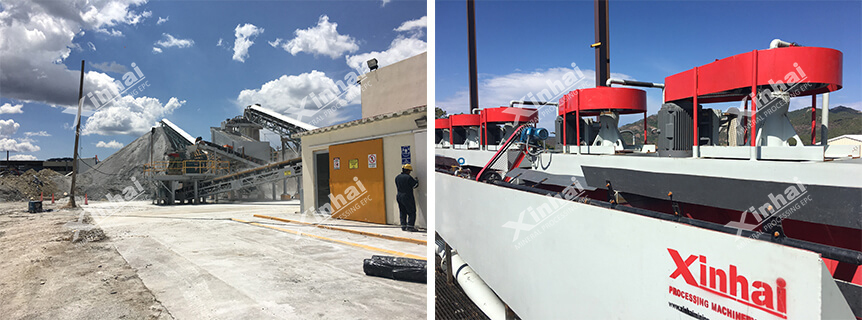
(Gold flotation plant in Mexico)
3. Gold Gravity Separation Method
Gravity separation method is the process of using the difference in the density and particle size of minerals to create suitable loose stratification and separation conditions by means of the combined action of medium fluid and various mechanical forces, so as to obtain products with different densities or different particle sizes. Since most gold-bearing ores contain a certain amount of coarse-grained free gold (+0.1mm), it is difficult to recover by flotation and hydrometallurgy. Therefore, the gravity separation method is mostly used to select placer gold and vein gold before and after flotation and leaching to recover coarse-grained gold from monomer dissociation. Generally, the lower limit of the particle size of gold that can be recovered by the gravity separation method is 0.01 mm.
(1) Gravity beneficiation process of placer/alluvial gold ore
① Jig for gold extraction
The main gold equipment for jigging is jigging machines, which mix mineral particles with different specific gravities and then stratifies them according to their specific gravity in a vertically moving variable-speed medium flow. The minerals with small specific gravity are located in the upper layer, and the minerals with heavier specific gravity are located in the lower layer for reuse. Through the machinery and water flow, the layered materials will be discharged separately. Jigging gold beneficiation is suitable for the separation of coarse mineral particles (mineral raw materials of any particle size except fine materials). The beneficiation size range of metal minerals is 0.074-50mm. For placer gold beneficiation, the difference in specific gravity is ≥1.25 and the ore monomer under the premise of dissociation, the lower limit particle size can reach 0.04mm. The process operation is simple and the equipment processing capacity is large, which is very effective in processing rough gold ore.
② Shaking table for gold extraction
The main equipment for gold separation on a shaker is shaking tables, a device for sorting in a horizontal medium flow. It uses a transmission mechanism to drive the bed surface to make longitudinal reciprocating motion and do rush flow and bed surface differential motion. These ore particles undergo the stratification perpendicular to the bed surface and the separation effect parallel to the bed surface in reciprocating motion, and then materials of different particle sizes are discharged from different sections of the bed surface to achieve separation.
Shaking gold beneficiation is suitable for processing and seperating minerals with finer particle size. According to the different particle sizes of the ore, it can be divided into three types: coarse sand bed, fine sand bed and ore mud bed. Among them, the coarse sand bed is suitable for separating ore particles with a particle size of 0.5-2.0mm, the fine sand bed is suitable for processing ore particles with a particle size range of 0.074-0.5mm, and the sludge bed is suitable for processing ore particles with a particle size of 0.037-0.074mm of ore grains.
The feeding particle size range of shaking gold beneficiation is generally between 0.019-3mm. This beneficiation method is stable and reliable, the ore belt distribution is clearly visible, the rich ore is higher than other beneficiation methods, easy to manage, and the required ore can be separated at one time.
③ Chute for gold extraction
The main equipment for gold selection in the chute is the spiral chutes, which use inclined water flow for separation. By the combined forces of water flow, mineral gravity, and friction between the ore particles and the bottom of the groove, the ore particles settle in the groove according to their specific gravity. And the ore particles with a small specific gravity are taken away by the water flow, leaving behind the ore particles with a large specific gravity to achieve separation. The spiral chute is suitable for processing fine-grained materials with low mud content. The material size ranges from 0.03-0.6mm. The structure is simple, the processing capacity is large, and the overall cost is low.
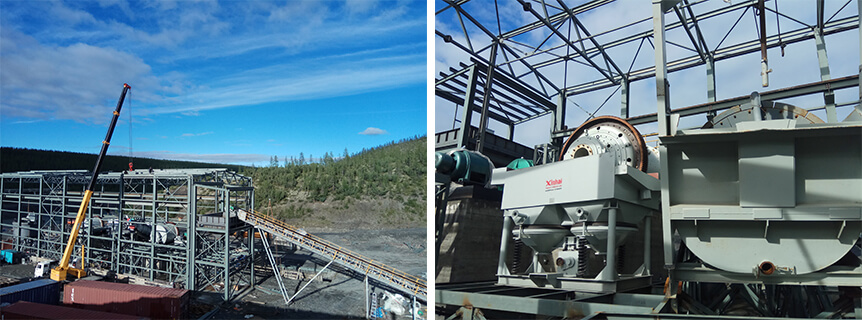
(Gold gravity plant in Russia)
(2) Vein gold gravity separation methods
In vein gold dressing plants, the gravity separation method is generally rarely used alone, but as a part of the combined gold separation process. Generally, in the grinding and classification circuit, a jig or spiral chute is used in conjunction with a shaker to recover the dissociated coarse-grained single gold in advance for facilitating subsequent flotation or cyanidation operations and obtaining qualified Gold concentrate. This kind of gold beneficiation method is widely used in local group mining of small gold mines.
① Gravity separation-Cyanide combined process
This gold ore beneficiation process is suitable for processing quartz vein gold-bearing oxide ore. The raw ore is in gravity separation process first, and the concentrate obtained from that is subjected to cyanidation to extract gold; or the raw ore is directly subjected to gravity separation, and then the tailings and graded ore are separately cyanidized.
② Gravity separation-Flotation combined process
This gold ore beneficiation process is to first use gravity separation to recover the coarse-grained gold in the ore, and then gravity separation of tailings is in the flotation process. The gold ore beneficiation process is suitable for processing single flotation processed ore, gold-bearing oxide ore and ore associated with free gold, and can obtain a higher recovery rate than a single flotation process.
③ Flotation-Gravity separation combined process
This gold ore beneficiation process is mainly based on flotation, which is suitable for ore that has close symbiosis of gold and sulfide and can only be recovered by smelting method. It is also suitable for gold-bearing quartz vein ore with coarse and uneven distribution. This benefication also can obtain a higher recovery rate than a single flotation process.
For gold gravity separation, it 's generally said that we use gravity separation to separate gold and heavy sand minerals for placer gold mine, while use flotation, gravity separation, cyanidation and other combined beneficiation processes to separate vein gold mines. Stage grinding and stage separation are used as much as possible with implementing the beneficiation principle of early harvest and recovers coarse-grained gold in time.
03To Wrap Up
BackThe above has taught you how to extract gold from ore. If you have other questions or want to get a complete solution for your gold processing plant, you can contact our online service.
 +86 183 3575 8886
+86 183 3575 8886 pinklaurabao@gmail.com
pinklaurabao@gmail.com




 Message
Message Chat Now
Chat Now



